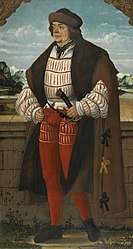Datei:Jester Knight Christoph by Hans Wertinger (1515, Thyssen-Bornemisza, Madrid).jpg
Zur Navigation springen
Zur Suche springen

Größe dieser Vorschau: 319 × 598 Pixel. Weitere Auflösungen: 128 × 240 Pixel | 256 × 480 Pixel | 409 × 768 Pixel | 546 × 1.024 Pixel | 1.599 × 3.000 Pixel
Originaldatei (1.599 × 3.000 Pixel, Dateigröße: 5,28 MB, MIME-Typ: image/jpeg)
Dateiversionen
Klicke auf einen Zeitpunkt, um diese Version zu laden.
| Version vom | Vorschaubild | Maße | Benutzer | Kommentar | |
|---|---|---|---|---|---|
| aktuell | 16:14, 16. Apr. 2017 |  | 1.599 × 3.000 (5,28 MB) | Elsbeere | same source, new url: https://www.museothyssen.org/node/16661; file now larger available |
| 22:10, 29. Jul. 2014 |  | 539 × 1.000 (148 KB) | Shakko | {{Information |Description=Hans Wertinger The Court Jester known as "Knight Christoph" 1515 Oil on canvas 113 x 61.5 cm Museo Thyssen-Bornemisza, Madrid INV. Nr. 434 (1934.32) Hans Wertinger was a German painter active in the first third of the 16th c... |
Dateiverwendung
Die folgende Seite verwendet diese Datei:
Globale Dateiverwendung
Die nachfolgenden anderen Wikis verwenden diese Datei:
- Verwendung auf en.wikipedia.org
- Verwendung auf it.wikipedia.org
- Verwendung auf ro.wikipedia.org
- Verwendung auf www.wikidata.org


